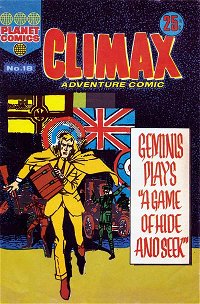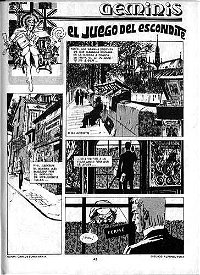Geminis by James Zee
Genesis of Geminis
The Australian run of Geminis began mid-1975 in Climax Adventure Comic, before transferring to Super Giant Album for the concluding episodes.11See the Geminis story tracking list....
Composed of eight episodes of 20 pages each, Geminis is an espionage story set during the first world war, from July 1914.
The series' title character Phil Jackson assists British Intelligence as anonymously as "Geminis", while being pursued by them for treason. He moves across the theatre of World War I, facing an array of archetypal villians, including German, British and Soviet soldiers and spies.
Geminis was created in 1973 at the suggestion of Selecciones Ilustradas director, Josep Toutain, specifically for international syndication and with an eye to the European market.22From an interview dated December 2008-January 2009 at www.tebeosfera.com....
All scripts are by Carlos Echevarría33There is little information published about Carlos Echevarría (possibly Carlos Echevarría Alonso), who worked with some of Spain's most famous... with art by Alfonso Font (b.1946).44Alfonso Font Carrera was born in Barcelona, Spain, 28 August 1946. In the 1960s, Font was published in Europe (especially... Font's art at this time reflects the work of Alberto Breccia (1919-1993), regarded as a master of black and white comic art.55Born in Uruquay in 1919, Alberto Breccia moved to Argentina at the age of three. In 1960, via the Bardon...
The KG Murray Publishing Company began printing this series soon after its creation, so it's possible Australians were among the first in the world to read the series.66At the time of writing, all identified international printings date from after the Australian printing. See the Geminis story... Around the time Geminis was first published in Spain, Font observed: "I am...a professional of thirteen years experience, yet only three or less for this country [Spain]... One begins to doubt by now if he is born here in Spain or in the Antipodes. To be published in a lot of different countries is flattering, but to not be published in your own country is frustrating."77From Totem 5 (Editorial Nueva Frontera, Madrid) 1977. The quote is from a letter titled "Our new comic artists" (p.4)...
It seems that Toutain brought Font and Echevarría together specifically for this project, as the partnership did not emerge spontaneously out of the "social club" environment that prevailed at Selecciones Ilustradas. Asked about working with Echevarría, Font commented, "We did not have a significant relationship. The few times we spoke, when we met at Selecciones, our meetings were cordial, but limited to professional contact."88From an interview dated 29 November 2007 at www.zonanegativa.com....
This was the creators' only joint work and their careers subsequently moved in different directions.
Echevarría became a prolific but largely anoymous scripter for many SI projects, and remains unrecognised despite a considerable body of work. In Font's case, Geminis provided a turning point in his career as he began to take the creative risks needed to become one of Spain's most accomplished comics' artists.



